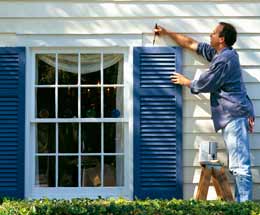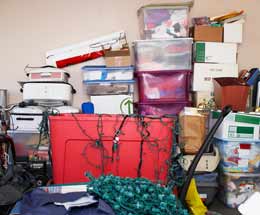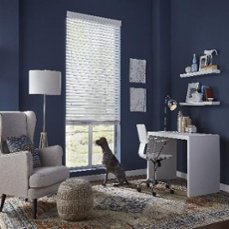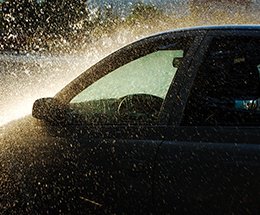
by Flagship Staff | Apr 25, 2018 | Blog
Depending on where you live, spring may have sprung. For some of us in the Midwest, we’re still waiting.
No matter where you live, weather can cause damage to your home. Bonnie Pesch, senior personal lines underwriter shares areas to examine on your home after a long, cold winter.
Windows: In the winter, windows ideally keep the cold air out and the warm air in, and in summer, they should do just the opposite. If your windows don’t do this, you’re probably wasting money on your heating/air conditioning bills.
To make sure your windows are doing their job, check that the caulking and weather stripping are still in good condition. If not, replace them. If there’s condensation on your window, either the glass or the window should be replaced. Faulty windows, as well as window trim that’s not maintained properly, can allow moisture into your home. That moisture can lead to mold and damaged dry wall.
Gutters: Gutters should direct water away from your home and help keep it out of your basement. It’s important, however, that the water NOT be directed over a walkway or driveway. If it freezes, it could create a liability exposure for you if someone slips or falls. Gutters expand and contract, depending on the temperature; they should be flush with the roof and not sag or dip.
Roof: Check for loose, missing, or cracked shingles. Are the shingles curling? What about nail-pops? These issues should be addressed to ensure water doesn’t get into your home. An aging roof can be a concern as shingles lose the ability to shed water as they age. Older shingles are also more prone to hail damage. If your roof is getting old, or you see even a small amount of deterioration, don’t wait too long! Over just one summer, sun exposure can increase the rate of the roof’s deterioration, and then before you know it winter in here. Don’t let that aging roof sit in the snow, ice, and rain, hoping no water gets into your home. What a mess it could be!
Foundations: Be sure to examine the foundation for any cracks that can allow water in. Sometimes just caulking cracks isn’t sufficient. Consider contacting a foundation specialist to assess your home.
Exterior Walls: Do you have water stains on your exterior walls? If so, this may be an indication that your gutters aren’t adequately containing rain water. Perhaps the gutters need to be cleaned or straightened. If you have wood siding, check for holes or openings that can allow ants, woodpeckers, or other critters to nest or burrow through. If the paint on your wood siding is peeling, you should properly scrape and re-paint the wood to protect it from the weather elements.
Chimneys: Mortar deterioration can lead to moisture. Repairing the mortar and replacing deteriorated bricks can be a DIY project, but if you’re not comfortable on the roof, call a professional. Also check the cap and screen to be sure they keep water from entering the flue inside the chimney. You should have your chimney/flue inspected and cleaned every year to make sure there are no cracks, deterioration, or debris blocking the hot air/smoke to escape. During the winter, we see a large number of home fires associated with chimneys.
Decks: You should check your deck periodically to be sure the posts are still solid, the deck boards haven’t rotted, and the railings aren’t wobbly. All of these create a liability exposure on your premises. What if someone would fall down the steps because the post or railing wasn’t maintained properly?
When everything is finished and in good condition, I suggest you plant some beautiful flowers, sit back on the deck, and watch your neighbors figure out what repairs they may need.

by Flagship Staff | Apr 17, 2018 | Blog
Whether you’re spring cleaning, downsizing, or preparing to move, getting rid of your unnecessary personal belongings can be a big endeavor. If you’ve experienced a recent death in the family or you’re going through a divorce the decluttering process can be even more stressful.
My parents have lived in their home for more than 40 years and went through this process a few years ago. As they progressed through different areas of their home, they found getting rid of “their junk” was therapeutic and a relief. Too much stuff or clutter in your home can make it difficult to find things, which can lead to stress.
Here are some tips to help you clean out or declutter your home this spring.
1. Break your home into sections. Depending on the size of your home and the items you’ve accumulated, this can be more than a day or weekend project. Prioritize and set completion dates for the different sections of your home you want to work on. This method won’t only help minimize feeling overwhelmed, it’ll also provide a sense of accomplishment when you cross it off the list.
2. Put it on the calendar. Look at your calendar and identify the days you want to work on this. Again, spending all day working on this project can be overwhelming and frustrating. Consider spreading it out over several days or even a month or two. Lastly, by having the project on your calendar, it can help avoid procrastination.
3. Ask for help. Consider asking friends and family members for help. Some extra sets of hands can speed up the process.
4. Make it fun. If family and friends are helping, play their favorite music or turn on their favorite sports team. In addition, consider buying them lunch or making them dinner to show your appreciation. Celebrate your success!
5. Avoid open-ended questions. Depending on the situation, getting rid of things can be emotional. By asking yes-no questions, decisions can be made more quickly, eliminating some of the emotion that may be present.
6. Create a sorting system. Before you start taking items out of your closet or from under the bed, have a sorting system in place. Label plastic storage bins or boxes with “Keep,” “Toss,” or “Donate.”
7. Coordinate with a community rummage sale. If your city or neighborhood has an annual rummage sale on a specified day or weekend, consider participating.
8. Use social media to sell items. A variety social media tools make it easy to promote items you want to sell. If you’ve never tried it, you’ll be amazed at the number of people you’ll reach.
9. Contact your local charities. If you don’t have donation organizations like Goodwill or St. Vincent DePaul nearby, contact local charities.
10. Research your disposal options. Moving items out of your home and into the garage with no place to go defeats your goal to declutter. Here are some disposal options to consider.
a. Can your items be placed in regular garbage collection?
b. Does your municipality allow you to arrange special curbside pickup?
c. Do you have a city drop off yard? If so, find out how you access it, what can be disposed of there, and hours of operation.
d. Is there a company that provides at home dumpsters? If so, research how much it costs and how long you can have it.
11. Apply the 12-month rule. If you haven’t used or worn something in the past year, does it make sense to keep it? I chuckle when it comes to this rule. I’ve struggled with weight my entire life. I have pants and shirts in many different sizes. I tend to keep them because I never know when the big weight loss or gain is going to happen so I have to be prepared. My wife often says, “Seriously, do you think you are ever going to wear that again?” After I ponder her question, the answer is usually “no.” If you don’t use it, lose it!

by Flagship Staff | Apr 10, 2018 | Blog
Moving from your home to another can be a daunting task, especially if you’re moving to a new city. Personal items can get lost or broken, heavy items can cause bodily injury, and your current furniture may not work in your new home. In addition, if you have kids, they may have their own worries, which can add another element of stress to the moving process.
As the weather warms up, and it gets closer to the end of the school year, more families will endure the moving process. If you’re moving with children here are some tips that may help.
1. Break the news gently. As adults, we often hear the phrase “change is good.” While that may be the case, trying to explain a job promotion to children can be difficult. When it comes time to talk to your kids about moving, make it a fun event. Take them to their favorite restaurant or park. Gradually work the idea of moving into the conversation. Talk about the new fun things you’ll be able to see and do in your new city.
2. Continue the conversation and planning with them. After you’ve introduced them to the idea of moving, keep them in the conversation. Talk to them about packing, colors for their new room, and meeting new friends. By keeping them in the conversation, you’ll be able to identify things that may trigger anxiety for them. This will allow you to talk to them about what is making them anxious. This is a much healthier approach than having them keep their emotions all “bottled up”.
3. Try not to deviate from normal schedules. Life can get hectic prior to the big move. Family dinners and bedtime schedules are often overlooked. Do your best to keep a bit of normalcy in your daily schedule. If Thursday night is family night, keep it on the schedule.
4. Keep in touch with family and friends. Today’s technology makes it easy to stay in touch with friends and family from afar. Develop a plan or talk to your kids about how they can stay in contact with family members and friends.
5. Take plenty of pictures. Before you move, take plenty of pictures of friends, your home, and other places that have created family memories. These pictures can be helpful during the transition to your new home, especially if you’ve moved to a new city. External hard drives and cloud storage make it easy to store photos. In addition, consider sharing pictures of your new home ahead of the move.
6. Make introductions. After you get settled into your new neighborhood, introduce your family to your neighbors. This makes it a lot easier for your kids to make new friends.
7. Spend adequate time at their new school. When it comes to moving, starting at a new school is probably the scariest element for them. Simple things like whom will they sit with at lunch or play with at recess can be overwhelming. Make sure you spend adequate time with their teachers and administrators. Tour the school frequently so they’re comfortable when the first day of class arrives.
8. Keep their favorite items close. Pack a small bag or suitcase with their favorite items. This can help keep them comfortable on long car or plane rides, as well as during an overnight hotel stay.

by Flagship Staff | Apr 3, 2018 | Blog
Cats and dogs add endless joy to our lives. They’re cute, cuddly, and unconditionally love us. However, pets also scratch, claw, break, and chew things. They can do their fair share of damage to the home if not properly trained (or if they just feel like it). Window treatments are tempting and present a prime opportunity for pets to get into mischief. After all, they’re just hanging there, asking to be swatted, tangled, and chewed on. Avoid the mess and safety hazard by choosing window treatments that can stand up to your furry friends.
Cordless blinds and shades
While dogs and cats may still claw and scrape at the blinds if they can reach them, cordless blinds take the cords out of the picture, so animals won’t get caught up in them. Ditch the cords and choose cordless shades or faux wood blinds that you easily open and close by pulling them up and down.
Faux wood blinds
Faux wood blinds are more durable than aluminum blinds, which means they’re less susceptible to clawing and scratching. They’re less expensive than wood blinds but look just as sophisticated. If one cracks or bends, you can easily order a replacement without breaking the bank. Unlike wood blinds, faux wood blinds are moisture-resistant. They can get wet and can be tugged at without falling apart. Also, the color on faux wood blinds is consistent throughout the slat, so if they get scratched, it’s less obvious.
Wide slat blinds
When they’re open, wide slat blinds let in more light than your average blinds and your cat or dog can see out of them more easily. They won’t be scratching at the blinds just to get more sunshine to nap in or to look for critters in the yard.
Vertical blinds
The areas in front of sliding doors and porch doors are the ultimate lounging spots for pets. Outfit these doors with vertical blinds with wand control. You can easily push vertical blinds to the side so your pet can hang out without being tempted to damage them. It also takes only a few minutes to replace one of the louvers if it comes dislodged.
Plantation shutters
Plantation shutters, which are typically made of wood and faux wood, are sturdier than blinds. Before you leave for the day, open them and let in the light. Your pet can sit by the window and look outside until you get home. However, keep in mind that wooden plantation shutters may not be the best choice if you have a new puppy or if your cat likes to scratch at wood.
Motorized shades
Motorized shades can be controlled with the touch of a remote or on your phone if they’re the smart kind. With the click of a button, you can roll them up. The need for cords is eliminated, reducing the temptation for pets.
Blinds can make your home more comfortable, help you save on energy costs, and complement your home’s decor. Make sure you choose a style that works for every member of your family, including the four-legged variety.
Katie Laird is the Director of Social Marketing for Blinds.com and a passionate home decorator for her family with a love of all things Mid-Century Modern and blue. Blinds.com carries a variety of faux wood blinds and other pet friendly window treatments on the website.

by Flagship Staff | Mar 27, 2018 | Blog
Spring has officially arrived! While many people breathe a sigh of relief because winter driving has ended, spring driving can also pose dangerous situations. It’s important to understand that each season change brings different driving conditions.
Here are some tips to keep you and your family safe on the roads this spring.
1. Be on the lookout for potholes. Extreme winter weather takes a toll on our roadways, creating large potholes. Heavy rain can fill them with water making them difficult to see. These monsters can damage your car leading to expensive repairs. Damages can include:
Punctured tires;
Bent rims;
Suspension damage;
Poor alignment; and
Exhaust system damage.
Keep a safe following distance in case the driver in front of you reacts. Never swerve to avoid a pothole. This can put you and your family in a more dangerous situation. Gently brake before it if you can.
2. Slow down for spring showers. Did you know that roads are the most slippery when it first begins to rain? This is caused by the rainwater mixing with contaminants on the road, such as oil and grease. Make sure to increase your following distance to allow for proper braking.
3. Watch for animals on the move. Animal activity increases during the spring. For some, this is mating season and for others, they’re waking up from their long winter slumber. Remember, deer are most active at dawn and dusk.
4. Watch for pedestrians on the move. As temperatures increase, more people are outside walking or bicycling with their families. Slow down in your neighborhood and pay extra attention at crosswalks. If pedestrians have the walk signal, they have the right of way.
5. Share the road with motorcycles. Because of their speed and size, motorcycles may quickly come in and out of your blind spots. Always take a second look now that motorcycles are out on the road. In addition, be courteous. Motorcycles have the same right to be on the road. If you end up following a motorcycle, maintain a safe following distance of at least four seconds.
6. Maintain proper tire air pressure. During the winter months, tires lose air due to the cold temperatures, causing tires to be underinflated. Warmer temperatures can cause tires to be overinflated. Each situation can lead to increased wear and poor handling.
7. Inspect your tires. Adequate tire tread is important for wet weather driving. Tire tread actually moves water away from the tires. As tire tread wears, less tread means reduced traction. When it comes time for buying new tires don’t focus only on price. Read reviews and recommendations. Remember, you’re relying on a contact patch the size of your hand to keep you and your family safe.
8. Pay attention in construction zones. When driving through construction zones, follow these tips.
Be attentive. Construction workers and equipment may suddenly enter the roadway. Traffic patterns can change daily to accommodate the work being done.
Understand and follow the signs.
Make safe lane changes. Solid lines in construction zones mean that you should stay in your lane.
Slow down. Fines may be doubled in construction zones. In addition, slowing down can save a life.





